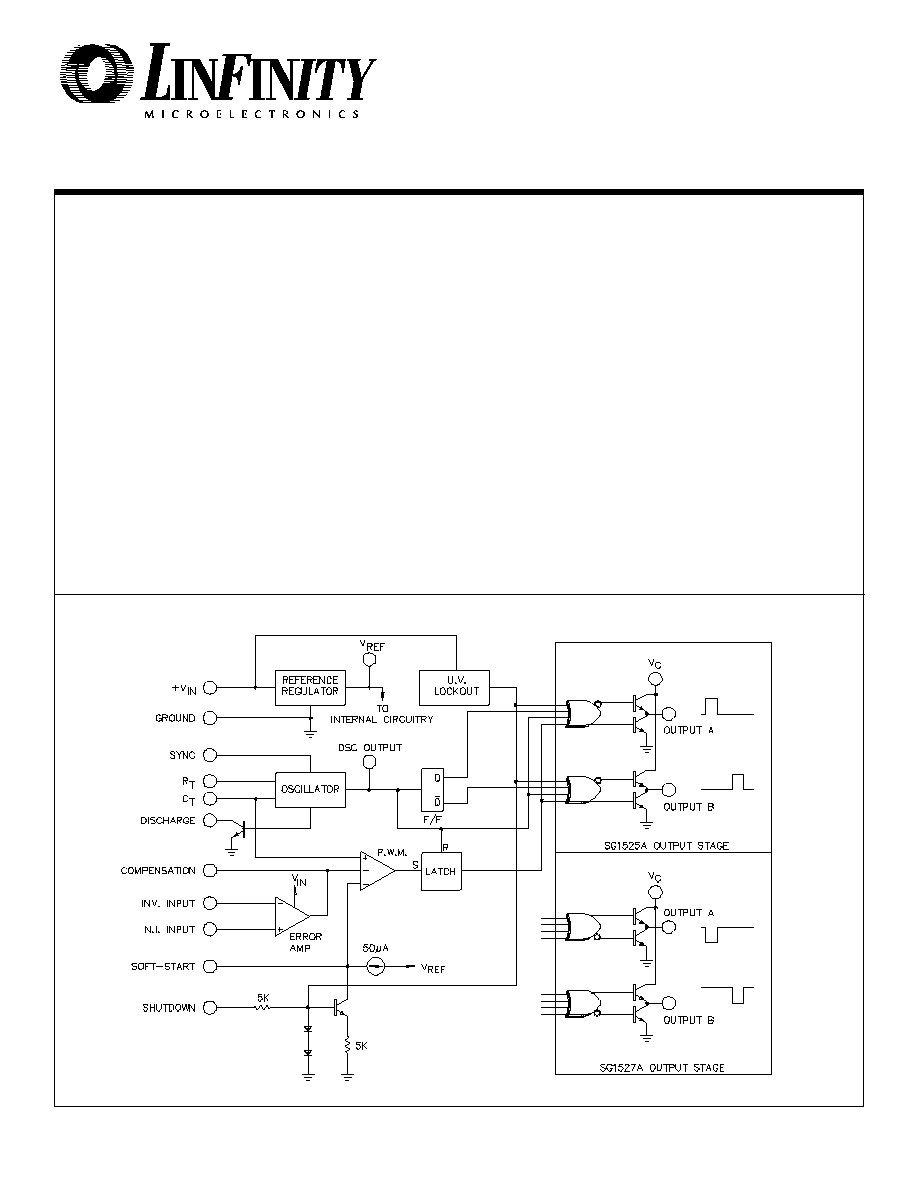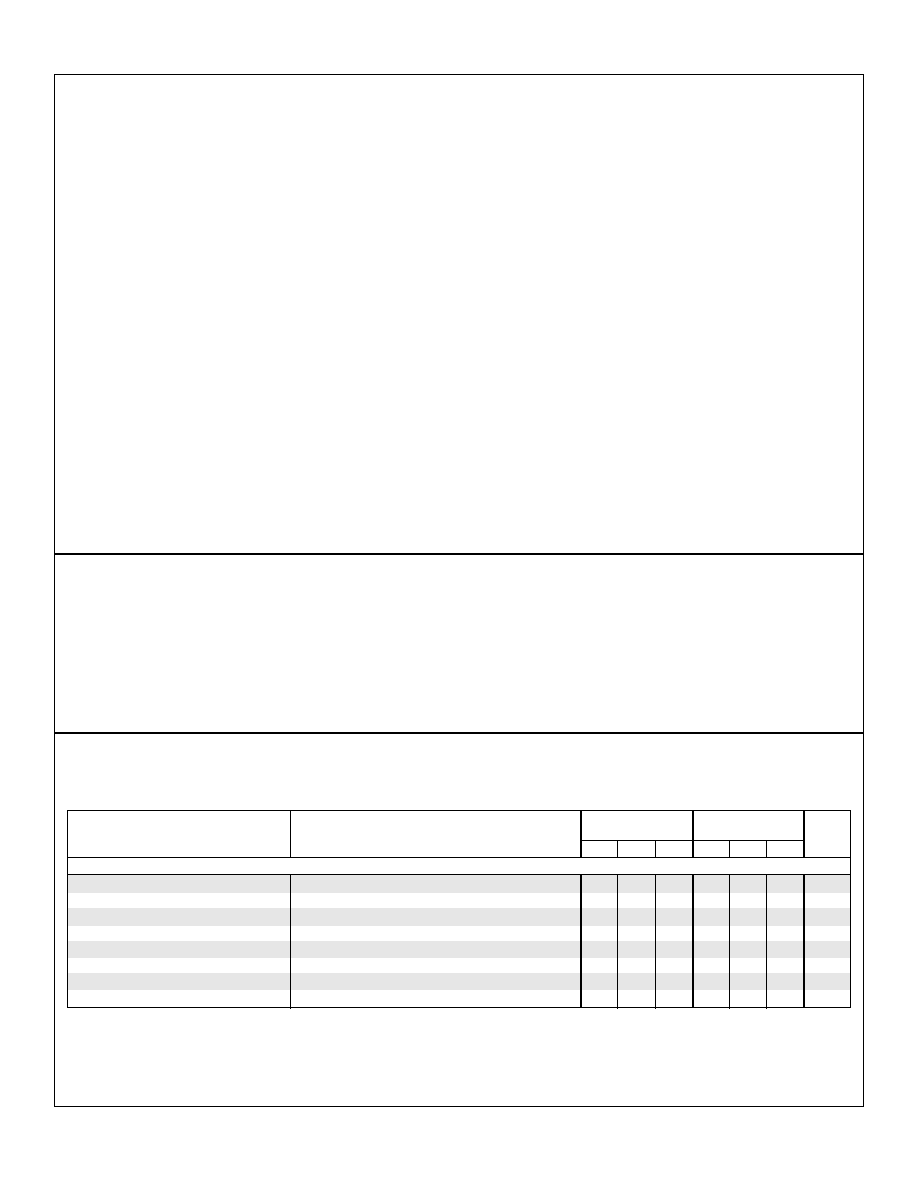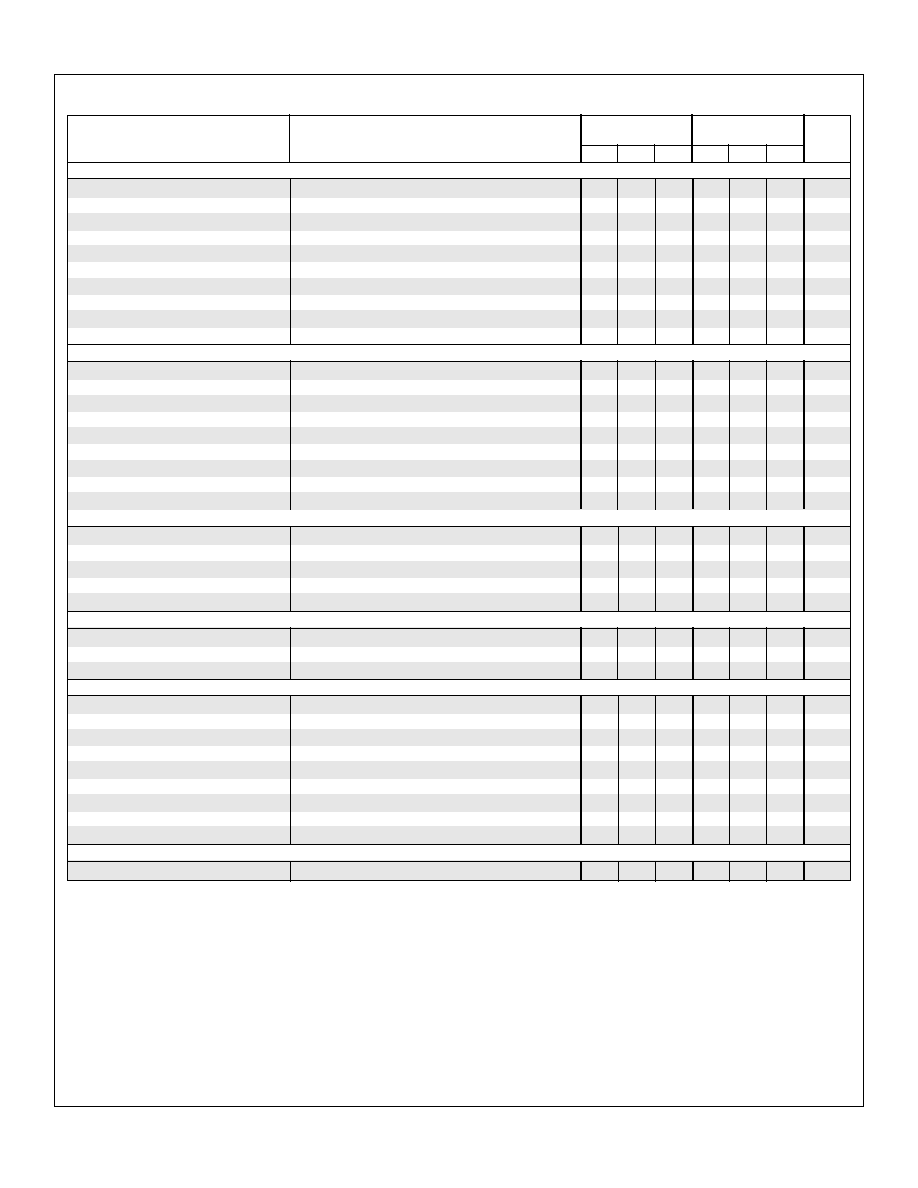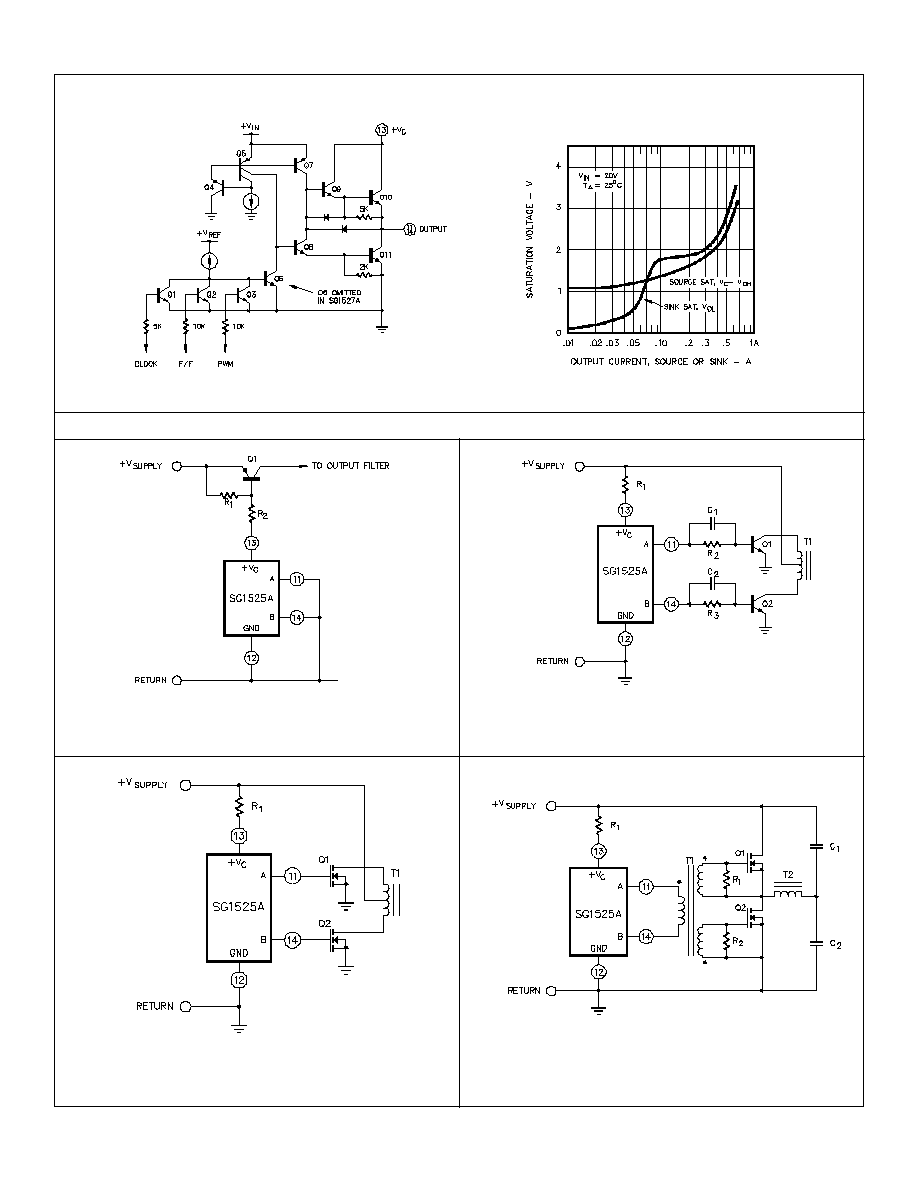
REGULATING PULSE WIDTH MODULATOR
FEATURES
∑∑
∑∑
∑
8V to 35V operation
∑∑
∑∑
∑
5.1V reference trimmed to ±1%
∑∑
∑∑
∑
100Hz to 500KHz oscillator range
∑∑
∑∑
∑
Separate oscillator sync terminal
∑∑
∑∑
∑
Adjustable deadtime control
∑∑
∑∑
∑
Internal soft-start
∑∑
∑∑
∑
Input undervoltage lockout
∑∑
∑∑
∑
Latching P.W.M. to prevent multiple
pulses
∑∑
∑∑
∑
Dual source/sink output drivers
HIGH RELIABILITY FEATURES
- SG1525A, SG1527A
Available to MIL-STD-883B
MIL-M38510/12602BEA - JAN1525AJ
MIL-M38510/12604BEA - JAN1527AJ
Radiation data available
LMI level "S" processing available
DESCRIPTION
The SG1525A/1527A series of pulse width modulator integrated circuits are
designed to offer improved performance and lower external parts count when used
to implement all types of switching power supplies. The on-chip +5.1 volt reference
is trimmed to ±1% initial accuracy and the input common-mode range of the error
amplifier includes the reference voltage, eliminating external potentiometers and
divider resistors. A Sync input to the oscillator allows multiple units to be slaved
together, or a single unit to be synchronized to an external system clock. A single
resistor between the C
T
pin and the Discharge pin provides a wide range of deadtime
adjustment. These devices also feature built-in soft-start circuitry with only a timing
capacitor required externally. A Shutdown pin controls both the soft-start circuitry
and the output stages, providing instantaneous turn-off with soft-start recycle for
slow turn-on. These functions are also controlled by an undervoltage lockout which
keeps the outputs off and the soft-start capacitor discharged for input voltages less
than that required for normal operation. Another unique feature of these PWM
circuits is a latch following the comparator. Once a PWM pulse has been terminated
for any reason, the outputs will remain off for the duration of the period. The latch
is reset with each clock pulse. The output stages are totem-pole designs capable
of sourcing or sinking in excess of 200mA. The SG1525A output stage features
NOR logic, giving a LOW output for an OFF state. The SG1527A utilizes OR logic
which results in a HIGH output level when OFF.
BLOCK DIAGRAM
SG1525A/SG2525A/SG3525A
SG1527A/SG2527A/SG3527A
11/91 Rev 1.3 10/96
L
INFINITY
Microelectronics Inc.
Copyright
©
1996
11861 Western Avenue
Garden Grove, CA 92841
1
(714) 898-8121
FAX: (714) 893-2570

SG1525A/SG1527A SERIES
11/91 Rev 1.3 10/96
L
INFINITY
Microelectronics Inc.
Copyright
©
1996
11861 Western Avenue
Garden Grove, CA 92841
2
(714) 898-8121
FAX: (714) 893-2570
Oscillator Charging Current ............................................
Operating Junction Temperature Range
Hermetic (J, L Packages) .....................................
Plastic (N, DW Packages ) .......................................
Storage Temperature Range ..........................
Lead Temperature (Soldering, 10 seconds) .................
Supply Voltage (+V
IN
) .......................................................
Collector Supply Voltage (V
C
) ...........................................
Logic Inputs .......................................................
Analog Inputs .......................................................
Output Current, Source or Sink ...................................
Reference Load Current ...............................................
40V
40V
-0.3V to 5.5V
-0.3V to V
IN
500mA
50mA
5mA
150
∞
C
150
∞
C
-65
∞
C to 150
∞
C
300
∞
C
ABSOLUTE MAXIMUM RATINGS
(Note 1)
Note 1. Values beyond which damage may occur.
Input Voltage (+V
IN
) ................................................
Collector Voltage (V
C
) ..........................................
Sink/Source Load Current (steady state) .............
Sink/Source Load Current (peak) .........................
Reference Load Current ........................................
Oscillator Frequency Range .......................
Oscillator Timing Resistor (R
T
) ........................
8V to 35V
4.5V to 35V
0 to 100mA
0 to 400mA
0 to 20mA
100Hz to 350KHz
2K
to 150K
Deadtime Resistor Range (R
D
) .............................
Maximum Shutdown Source Impedance .........................
Oscillator Timing Capacitor (C
T
) ...................
Operating Ambient Temperature Range
SG1525A/SG1527A ....................................
SG2525A/SG2527A ......................................
SG3525A/SG3527A .........................................
0
to 500
5K
0.001
µ
F to 0.1
µ
F
-55
∞
C to 125
∞
C
-25
∞
C to 85
∞
C
0
∞
C to 70
∞
C
Note 2: Range over which the device is functional.
RECOMMENDED OPERATING CONDITIONS
(Note 2)
ELECTRICAL CHARACTERISTICS
(Unless otherwise specified, these specifications apply over the operating ambient temperatures for SG1525A/SG1527A with -55
∞
C
T
A
125
∞
C,
SG2525A/SG2527A with -25
∞
C
T
A
85
∞
C, SG3525A/SG3527A with 0
∞
C
T
A
70
∞
C, and +V
IN
= 20V. Low duty cycle pulse testing techniques are
used which maintains junction and case temperatures equal to the ambient temperature.)
5.05
5.00
Reference Section
T
J
= 25
∞
C
V
IN
= 8V to 35V
I
L
= 0 to 20mA
Over Operating Temperature Range
Over Line, Load and Temperature
V
REF
= 0V, T
J
= 25
∞
C
10Hz
f
10KHz, T
J
= 25
∞
C
T
J
= 125
∞
C
Output Voltage
Line Regulation
Load Regulation
Temperature Stability
(Note 3)
Total Output Voltage Range
(Note 3)
Short Circuit Current
Output Noise Voltage
(Note 3)
Long Term Stability
(Note 3)
Min. Typ. Max. Min. Typ. Max.
Note 3. These parameters, although guaranteed over the recommended operating conditions, are not 100% tested in production.
Note 4. F
OSC
= 40KHz (R
T
= 3.6K
, C
T
= 0.01
µ
F, R
D
= 0
)
Note 5. Applies to SG1525A/2525A/3525A only, due to polarity of output pulses.
SG3525A
SG3527A
SG1525A/2525A
SG1527A/2527A
Units
Test Conditions
Parameter
V
mV
mV
mV
V
mA
µ
Vrms
mV/khr
5.20
30
50
50
5.25
100
200
50
5.10
10
20
20
80
40
20
5.00
4.95
5.15
30
50
50
5.20
100
200
50
5.10
10
20
20
80
40
20
THERMAL DATA
J Package:
Thermal Resistance-
Junction to Case
,
JC
.................. 30∞C/W
Thermal Resistance-
Junction to Ambient
,
JA
.............. 80∞C/W
DW Package:
Thermal Resistance-
Junction to Case
,
JC
.................. 40∞C/W
Thermal Resistance-
Junction to Ambient
,
JA
............. 95∞C/W
L Package:
Thermal Resistance-
Junction to Case
,
JC
.................. 35∞C/W
Thermal Resistance-
Junction to Ambient
,
JA
........... 120∞C/W
N Package:
Thermal Resistance-
Junction to Case
,
JC
................... 40∞C/W
Thermal Resistance-
Junction to Ambient
,
JA
............. 65∞C/W
Note A. Junction Temperature Calculation: T
J
= T
A
+ (P
D
x
JA
).
Note B. The above numbers for
JC
are maximums for the limiting
thermal resistance of the package in a standard mount-
ing configuration. The
JA
numbers are meant to be
guidelines for the thermal performance of the device/pc-
board system. All of the above assume no ambient
airflow.

SG1525A/SG1527A SERIES
11/91 Rev 1.3 10/96
L
INFINITY
Microelectronics Inc.
Copyright
©
1996
11861 Western Avenue
Garden Grove, CA 92841
3
(714) 898-8121
FAX: (714) 893-2570
18
17
6
Output Drivers Section
(each transistor, V
C
= 20V)
I
SOURCE
= 20mA
I
SOURCE
= 100mA
I
SINK
= 20mA
I
SINK
= 100mA
V
COMP
and V
SS
= High
V
C
= 35V
C
L
= 1nF, T
J
= 25
∞
C
C
L
= 1nF, T
J
= 25
∞
C
V
SD
= 3V, C
S
= 0, T
J
= 25
∞
C
Output High Level
Output Low Level
Undervoltage Lockout
Collector Leakage
(Note 5)
Rise Time
Fall Time
Shutdown Delay
(Note 3)
50
0.4
0.4
25
Soft-Start Section
V
SHUTDOWN
= 0V
V
SHUTDOWN
= 2V
V
SHUTDOWN
= 2.5V
Soft Start Current
Soft Start Voltage
Shutdown Input Current
µ
A
V
mA
P.W.M. Comparator Section
V
COMP
= 0.6V
V
COMP
= 3.6V
Zero Duty Cycle
Maximum Duty Cycle
Minimum Duty Cycle
Maximum Duty Cycle
Input Threshold
(Note 4)
Input Bias Current
%
%
V
V
µ
A
0.4
2.2
8
200
600
300
0.5
19
18
0.2
1.0
7
100
50
0.2
37.6
350
1.7
3.0
0.3
1.2
Oscillator Section
(Note 4)
T
J
= 25
∞
C
V
IN
= 8V to 35V
MIN
T
J
MAX
R
T
= 150K
, C
T
= 0.1
µ
F
R
T
= 2K
, C
T
= 1nF
I
RT
= 2mA
T
J
= 25
∞
C
Sync Voltage = 3.5V
Initial Accuracy
Voltage Stability
Temperature Stability
(Note 3)
Minimum Frequency
(Note 3)
Maximum Frequency
(Note 3)
Current Mirror
Clock Amplitude
Clock Width
Sync Threshold
Sync Input Current
Min. Typ. Max. Min. Typ. Max.
SG3525A
SG3527A
SG1525A/2525A
SG1527A/2527A
Units
Test Conditions
Parameter
ELECTRICAL CHARACTERISTICS
(continued)
KHz
%
%
Hz
KHz
mA
V
µ
s
V
mA
42.4
±2
±6
150
2.2
1.0
2.8
2.5
40
±1
±3
2.0
3.5
0.5
2.0
1.0
37.6
350
1.7
3.0
0.3
1.2
42.4
±1
±6
150
2.2
1.0
2.8
2.5
40
±0.3
±3
2.0
3.5
0.5
2.0
1.0
Error Amplifier Section
(V
CM
= 5.1V)
Input Offset Voltage
Input Bias Current
Input Offset Current
DC Open Loop Gain
Gain-Bandwidth Product
(Note 3)
Output Low Level
Output High Level
Common Mode Rejection
Supply Voltage Rejection
R
L
10M
,
T
J
= 25
∞
C
A
V
= 0dB, T
J
= 25
∞
C
V
CM
= 1.5V to 5.2V
V
IN
= 8V to 35V
60
1
3.8
60
50
0.5
1
75
2
0.2
5.6
75
60
5
10
1
0.5
60
1
3.8
60
50
2
1
75
2
0.2
5.6
75
60
10
10
1
0.5
mV
µ
A
µ
A
dB
MHz
V
V
dB
dB
45
0.6
0
3.6
2.0
49
0.9
3.3
.05
45
0.6
0
3.6
2.0
49
0.9
3.3
.05
80
0.6
1.0
25
50
0.4
0.4
80
0.6
1.0
19
18
0.2
1.0
7
100
50
0.2
18
17
6
0.4
2.2
8
200
600
300
0.5
V
V
V
V
V
µ
A
ns
ns
µ
s
Total Standby Current
Standby Current
V
IN
= 35V
mA
20
14
20
14

SG1525A/SG1527A SERIES
11/91 Rev 1.3 10/96
L
INFINITY
Microelectronics Inc.
Copyright
©
1996
11861 Western Avenue
Garden Grove, CA 92841
5
(714) 898-8121
FAX: (714) 893-2570
FIGURE 7 - OUTPUT SATURATION CHARACTERISTICS
FIGURE 6 -OUTPUT CIRCUIT (Ω Circuit Shown)
APPLICATION INFORMATION
Low power transformers can be driven directly by the SG1525A.
Automatic reset occurs during deadtime, when both ends of the
primary winding are switched to ground.
The low source impedance of the output drivers provides rapid
charging of power FET input capacitance while minimizing exter-
nal components.
For single-ended supplies, the driver outputs are grounded. The
V
C
terminal is switched to ground by the totem-pole source
transistors on alternate oscillator cycles.
In conventional push-pull bipolar designs, forward base drive is
controlled by R
1
- R
3
. Rapid turn-off times for the power devices
are achieved with speed-up capacitors C
1
and C
2
.
OUTPUT SECTION




